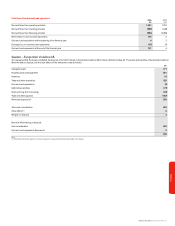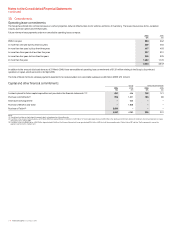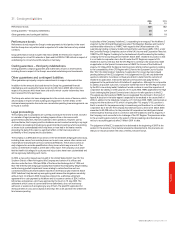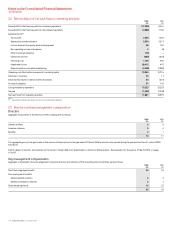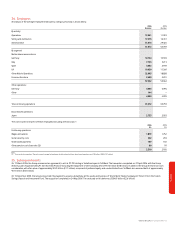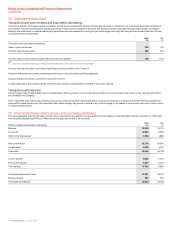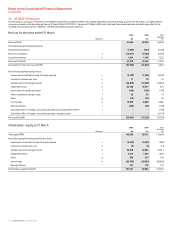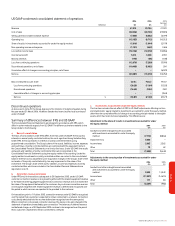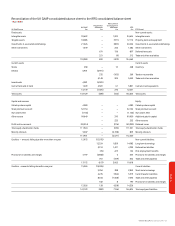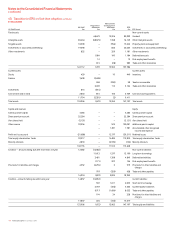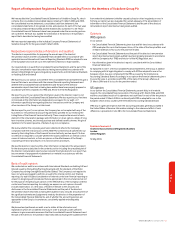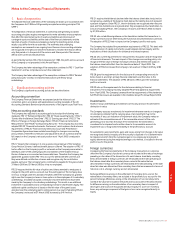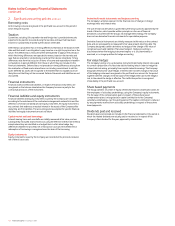Vodafone 2006 Annual Report Download - page 126
Download and view the complete annual report
Please find page 126 of the 2006 Vodafone annual report below. You can navigate through the pages in the report by either clicking on the pages listed below, or by using the keyword search tool below to find specific information within the annual report.
124 Vodafone Group Plc Annual Report 2006
Notes to the Consolidated Financial Statements
continued
38. US GAAP information continued
d. Goodwill and other intangible assets
The differences related to goodwill and other intangible assets included in the
reconciliations of net loss and shareholders’ equity relate to acquisitions prior to the
Group’s adoption of SEC guidance issued on 29 September 2004. In determining the
value of licences purchased in business combinations prior to 29 September 2004, the
Group allocated the portion of the purchase price, in excess of the fair value attributed to
the share of net assets acquired, to licences. The Group had previously concluded that
the nature of the licences and the related goodwill acquired in business combinations
was fundamentally indistinguishable.
Following the adoption of the SEC guidance issued on 29 September 2004, the Group’s
US GAAP accounting policy for initial and subsequent measurement of goodwill and
other intangible assets, other than determination of impairment of goodwill and finite
lived intangible assets, is substantially aligned to that of IFRS described in note 2.
However, there are substantial adjustments arising prior to 29 September 2004 from
different methods of transition to current IFRS and US GAAP as discussed below.
Goodwill arising before the date of transition to IFRS has been retained under IFRS at the
previous UK GAAP amounts for acquisitions prior to 1 April 2004. The Group has
assigned amounts to licences and customer bases under US GAAP as they meet the
criteria for recognition separately from goodwill, while these had not been recognised
separately from goodwill under UK GAAP because they did not meet the recognition
criteria. Under US GAAP, goodwill and other intangible assets with indefinite lives are
capitalised and not amortised, but tested for impairment at least annually. Intangible
assets with finite lives are capitalised and amortised over their useful economic lives.
Under IFRS and US GAAP, the purchase price of a transaction accounted for as an
acquisition is based on the fair value of the consideration. In the case of share
consideration, under IFRS the fair value of such consideration is based on the share price
on the date of exchange. Under US GAAP, the fair value of the share consideration is
based on the average share price over a reasonable period of time before and after the
proposed acquisition is agreed to and announced. This has resulted in a difference in the
fair value of the consideration for certain acquisitions and consequently in the amount of
goodwill capitalised under IFRS and US GAAP.
The Group’s accounting policy for testing goodwill and finite lived intangible assets for
impairment under IFRS is discussed in note 2. For the purpose of goodwill impairment
testing under US GAAP, the fair value of a reporting unit including goodwill is compared
to its carrying value. If the fair value of a reporting unit is lower than its carrying value,
the fair value of the goodwill within that reporting unit is compared to its respective
carrying value, with any excess carrying value written off as an impairment loss. The fair
value of the goodwill is the difference between the fair value of the reporting unit and
the fair value of the identifiable net assets of the reporting unit. Intangible assets with
finite lives are subject to periodic impairment tests when circumstances indicate that an
impairment loss may exist. Where an asset’s (or asset group’s) carrying amount exceeds
its sum of undiscounted future cash flows, an impairment loss is recognised in an
amount equal to the amount by which the asset’s (or asset group’s) carrying amount
exceeds its fair value, which is generally based on discounted cash flows.
As a result of the above, there are significant amounts reported as goodwill and not
amortised under IFRS which are reported as licences, customers and deferred tax
liabilities under US GAAP.
During the year ended 31 March 2005, the Group undertook a number of transactions,
including a stake increase in Vodafone Hungary. Under US GAAP, these transactions have
resulted in the Group assigning £65 million to intangible assets, of which £21 million was
assigned to cellular licences and £20 million to customer bases. A corresponding
deferred tax liability of £8 million was recognised. All intangible assets acquired, other
than goodwill, are deemed to be of finite life, with a weighted average amortisation period
of 8 years, comprising licences of 10 years and customer bases of 5 years.
Finite-lived intangible assets 2006 2005
Licences £m £m
Gross carrying value 154,135 152,831
Accumulated amortisation (75,170) (61,188)
78,965 91,643
Customer bases
Gross carrying value 1,663 5,952
Accumulated amortisation (1,071) (5,333)
592 619
The total amortisation charge for the year ended 31 March 2006, under US GAAP, was
£15,011 million (2005: £15,400 million). The estimated future amortisation charge on
finite-lived intangible assets for each of the next five years is set out in the following
table. The estimate is based on finite-lived intangible assets recognised at 31 March
2006 using foreign exchange rates on that date. It is likely that future amortisation
charges will vary from the figures below, as the estimate does not include the impact of
any future investments, disposals, capital expenditures or fluctuations in foreign
exchange rates.
Year ending 31 March £m
2007 15,448
2008 15,362
2009 15,264
2010 12,367
2011 3,754
e. Impairment losses
As discussed in note 10, during the year ended 31 March 2006, the Group recorded
impairment losses of £23,000 million in relation to the goodwill of Vodafone Germany
and Vodafone Italy under IFRS. Under US GAAP, the Group evaluated the recoverability of
the long-lived assets, comprised primarily of licences, in Vodafone Germany and
Vodafone Italy using undiscounted cash flows and determined that the carrying amount
of these assets was recoverable. As a result, the IFRS impairment losses of £23,000
million related to Vodafone Germany and Vodafone Italy were not recognised under
US GAAP.
During the year ended 31 March 2006, the Group also recorded an impairment loss
under IFRS of £515 million and £4,900 million in relation to the goodwill of Vodafone
Sweden and Vodafone Japan, respectively. Under US GAAP, the Group recognised
impairment losses of licences of £883 million and £8,556 million in Vodafone Sweden
and in Vodafone Japan. As a result of these impairment losses, the Group released
related deferred tax liabilities of £247 million and £3,508 million, which have been
included in the adjustment for income taxes. The impairment losses on Vodafone
Sweden’s and Vodafone Japan’s licences have been included in discontinued operations
under US GAAP.
Cumulative cumulative foreign currency gains and losses arising on the translation of
the assets and liabilities into sterling have been included in the carrying value of a
discontinued operation when assessing that carrying value for impairment.
f. Capitalised interest
Under IFRS, the Group has adopted the benchmark accounting treatment for borrowing
costs and, as a result, the Group does not capitalise interest costs on borrowings in
respect of the acquisition or construction of tangible and intangible fixed assets. Under
US GAAP, the interest costs of financing the acquisition or construction of network
assets and other fixed assets is capitalised during the period of construction until the
date that the asset is placed in service. Interest costs of financing the acquisition of
licences are also capitalised until the date that the related network service is launched.
Capitalised interest costs are amortised over the estimated useful lives of the related
assets.
g. Other
Financial instruments
Under IFRS, the equity put rights and similar arrangements are classified as financial
liabilities. The liabilities are measured as the present value of the estimated exercise
prices of the equity put rights and similar arrangements, which is the fair value of the
underlying shares on the date of exercise, with any changes in this estimate recognised
in the consolidated income statement each period. Under US GAAP, these equity put
rights and similar arrangements are generally classified as derivative instruments.
Consequently, this financial liability is eliminated for US GAAP purposes and the equity
put rights and similar arrangements are accounted for at fair value.
Pensions
Under both IFRS and US GAAP, the Group recognises actuarial gains and losses as they
are incurred. Under IFRS, these gains and losses are recognised directly in equity. These
gains and losses are included in the determination of net loss under US GAAP.
Other recognised income and expense
Under both IFRS and US GAAP, the cumulative foreign currency gains and losses arising
on the translation of the assets and liabilities of entities with a functional currency other
than sterling are reclassified from accumulated other recognised income and expense
and included in the determination of profit for the period or net loss on sale or liquidation
of a foreign entity. Differences in the amount reclassified arise due to differences in the
carrying values of the underlying net assets and because the Group deemed the
cumulative translation differences at the date of transition to IFRS to be zero.



